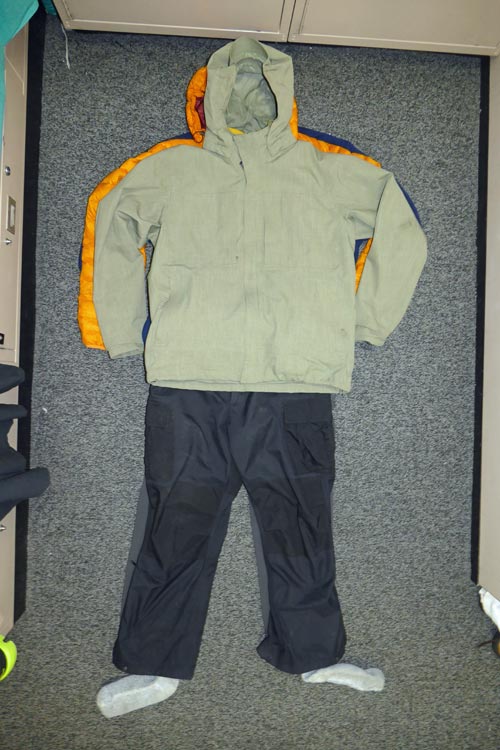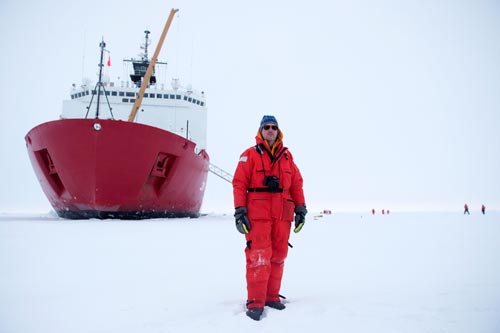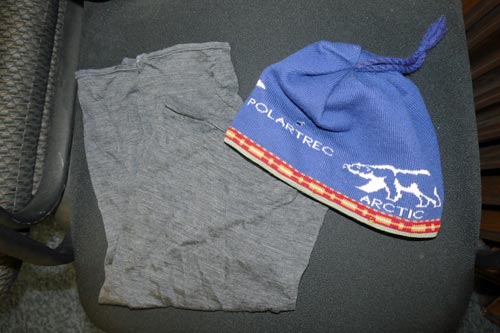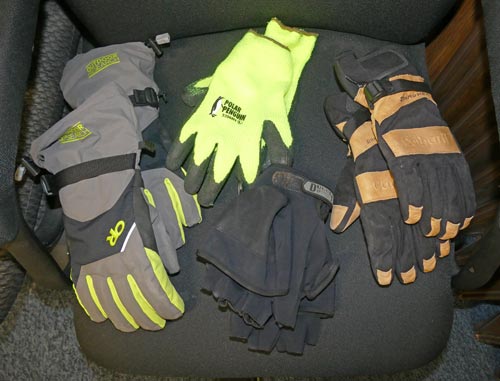Cruise Day 40
Speed 0 knots (kts) (on station)
Course n/a
Location Alpha Ridge, ~350 nautical miles south of N. Pole
Depth 2025 m
GO DEEPER DISCUSSION: (see previous journal for the questions.)
There are five countries with coasts on the Arctic Ocean: The United States, Canada, Russia, Norway, and Denmark (via Greenland, which is Danish territory.)
TODAY’S JOURNAL:
We’re stopped for a short repeat hydrography station near 87°N, 150°W. As we approached the station we passed a polar bear (the fourth of the cruise) about 1/2 kilometer out on the ice. Our last sign of polar bears were tracks seen on Sept. 4 at 88.63°N, 179.88°E, and the last bear we saw was on August 23. I’m hoping as we head south through the Canada Basin we’ll be back in prime ice bear territory. After we stopped, the bear walked close to the ship for a sniff-around and then headed back out on its loping patrol for seals.
It is still quite cold today, with even light breezes biting any bare skin. I know readers from colder areas will have some experience dressing for harsh weather like this, but thought it would be informative and fun to show what I’ve been wearing to stay comfortable for hours on deck or on the ice in less-than-balmy conditions. The key isn’t to have a single super garment, but rather to go with layers of clothes. This allows for easier adjustment if conditions change and better overall comfort in the cold weather. I begin with a so-called base layer consisting of Merino wool or synthetic long underwear. Cotton long Johns are best avoided – they aren’t as warm and if you sweat or otherwise get it wet they get really cold while the wool or synthetic versions wick away sweat and stay cozy. For my feet I go with mid-weight wool boot socks.
 Base layer: Merino wool long underwear and wool boot socks.
Base layer: Merino wool long underwear and wool boot socks.
Next I put on a hiking shirt and soft-shell pants. Soft shell material has thin insulation and is nearly windproof. I throw on a cozy fleece sweater over the hiking shirt for a good insulating mid-layer.
 A pair of soft-shell pants, hiking shirt, and synthetic fleece top form a comfortable mid-layer.
A pair of soft-shell pants, hiking shirt, and synthetic fleece top form a comfortable mid-layer.
If it isn’t too cold (say, maybe in the 20’s or low 30’s), I’m ready to go with only a shell or Mustang Suit (more on this item later.) But with the single-digits and negative wind chills, I bolster the fleece with a hooded down sweater.
 A hooded down sweater adds significant warmth either worn as an outer layer or if worn under a shell.
A hooded down sweater adds significant warmth either worn as an outer layer or if worn under a shell.
If I was just going outside to look around, I’d finish the ensemble with insulated snow pants and a waterproof shell.
 An outer layer of insulated snow pants and a waterproof shell jacket shed any wind and seal in warmth.
An outer layer of insulated snow pants and a waterproof shell jacket shed any wind and seal in warmth.
For deck work and ice stations, we are required to wear a Mustang Suit. These have three nice roles:
- First, they are floatation devices and would buy some time if we went in the water. They aren’t dry suits, though, so this is really not something any of us want to use the Mustang Suit for. But just in case, they would keep us afloat and have a whistle and strobe light along with a tube to inflate an extra pillow of air behind the head.
- Second, Mustang Suits have a lot of windproof insulation and make a cozy outer layer.
- Finally, Mustang Suits keep us dry when working with wet sampling gear and if it is raining or snowing.
 A mustang suit really finishes off the ensemble with flotation, insulation, and waterproofing. Plus, everyone looks great in safety orange! Photo by Petty Officer 2nd Class Cory Mendenhall.
A mustang suit really finishes off the ensemble with flotation, insulation, and waterproofing. Plus, everyone looks great in safety orange! Photo by Petty Officer 2nd Class Cory Mendenhall.
Extremities also need considerations in Arctic conditions. I like to wear a stretchy Merino wool Buff for a neck gaiter. If I need to I can pull it up over my face, ears, and crown for a balaclava in really chilly conditions. I top that with a wool beanie, and I often pull my down sweater hood on top of it all. On deck we wear hard hats, which don’t offer much (if anything) for warmth but protect against falling gear and ice or bumping noggins into stuff.
 A stretchy Merino wool Buff adds a lot of versatility including use as a neck gaiter and balaclava, while a wool beanie keeps the cranium toasty under a hard hat.
A stretchy Merino wool Buff adds a lot of versatility including use as a neck gaiter and balaclava, while a wool beanie keeps the cranium toasty under a hard hat.
For my hands I brought several glove choices. If I’m just out for a little while doing photography and/or wildlife watching I like my pair of glommits – they are fingerless gloves with mitten covers that pull over thumb and fingertips when dexterity isn’t needed. When I’m out for ice operations I wear waterproof ski gloves, and for deck work I wear waterproof work gloves or lighter grippy-palmed stretchy work gloves, depending on how cold it is. Some folks like thin liner gloves as well but I usually don’t have too much trouble with cold fingers so I haven’t been using these.
 I have a few different types of gloves to choose from depending on how cold it is and what I’ll be doing.
I have a few different types of gloves to choose from depending on how cold it is and what I’ll be doing.
Toasty toes go a long way towards making me a happy camper, so when I’m out for cold deck work I add a pair of tall socks over my boot socks to wear inside my steel-toed rubber work boots. When loads are being lifted up and down, such as the sampling rosette I help with, we are required to wear this kind of boot to protect against crushed toes. When I’m going out on the ice I opt for warmer, more comfortable Arctic Pro Muck Boots – they aren’t as heavy as the steel-toed boots but have cozy insulation to calf height and a really comfortable insole for walking around. I think they add about two inches to my height, too! (When I’m wearing those I get to feel what it’s like to be six feet tall.)
 For deck work I wear steel-toed rubber Xtratuff work boots with tall over-socks, and when I’m on the ice I wear Arctic Pro Muck Boots.
For deck work I wear steel-toed rubber Xtratuff work boots with tall over-socks, and when I’m on the ice I wear Arctic Pro Muck Boots.
GO DEEPER!
As I write today’s journal, the air temperature is 10° F and the wind chill is -5° F. What does the wind chill temperature mean?
Aloft Con web cam updated every hour
Healy Track
That's all for now. Best- Bill


Comments